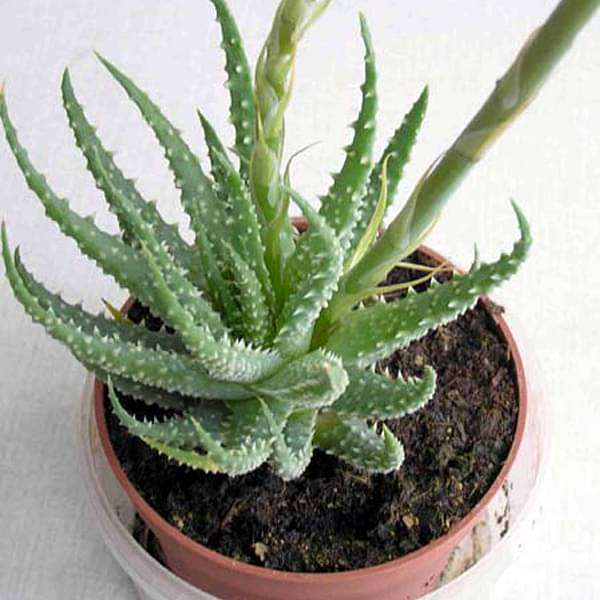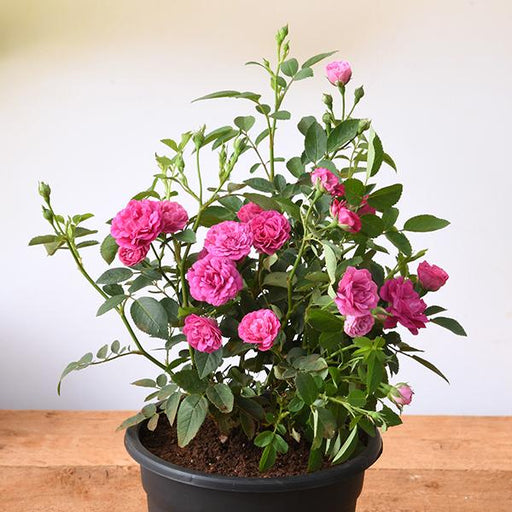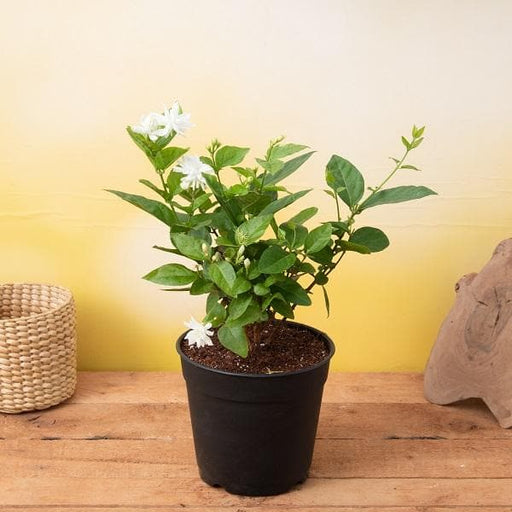
Aloe humilis - Succulent Plant
(MRP Inclusive of all taxes)
- Shipping ₹79 for entire order
- Dispatch in 7 days
- Country of origin: India

(MRP Inclusive of all taxes)
 Save 29%
Save 29%
Air Purifier Money Plant with Pot The Air Purifier Money Plant, also known as Pothos or Epipremnum aureum, is a stunning indoor plant that...
View full details
 Save up to 15%
Save up to 15%
Peace Lily, Spathiphyllum - Plant The Peace Lily, scientifically known as Spathiphyllum, is a stunning houseplant celebrated for its elegant white...
View full details
 Save 25%
Save 25%
Jasminum sambac, Mogra, Arabian Jasmine - Plant Jasminum sambac, commonly known as Mogra or Arabian Jasmine, is a fragrant flowering plant...
View full details
 Save 18%
Save 18%
Combo Constituents Includes the Parijat Tree (Night-Flowering Jasmine), a culturally significant plant with fragrant flowers. Description The Pari...
View full details
 Save 25%
Save 25%
Miniature Rose, Button Rose (Any Color) - Plant The Miniature Rose, also known as the Button Rose, is a charming and compact flowering plant that ...
View full details Save 25%
Save 25%
Damascus Rose, Scented Rose (Any Color) - Plant The Damascus Rose, also known as Rosa damascena, is a timeless symbol of beauty and romanc...
View full details
 Save 17%
Save 17%
Beautiful Fragrant Mogra, Arabian Jasmine Plant with Pot The Beautiful Fragrant Mogra, also known as Arabian Jasmine (Jasminum sambac), is...
View full details Save 15%
Save 15%
Pack of Vermicompost and Neem Cake for House Plants Transform your indoor garden with our premium Pack of Vermicompost and Neem Cake, spec...
View full details
Pack of Plant Growth and Flower Boosters Unlock the full potential of your garden with our Pack of Plant Growth and Flower Boosters! This ...
View full details Save 38%
Save 38%
Combo of Jeevamrut and Neem Raksha for Easy Growth and Protection of Houseplants Transform your indoor garden with our exclusive combo of ...
View full details Save 22%
Save 22%
Plant Nutrients Kit (Pack of 16) for a Healthy Garden Transform your garden into a lush paradise with our Plant Nutrients Kit, featuring 1...
View full details Save 16%
Save 16%
Combo of Top Plant Fertilizers Elevate your gardening game with our exclusive Combo of Top Plant Fertilizers, featuring two bags of premiu...
View full details Save 24%
Save 24%
Pack of 4 Additives to Make Soil Healthy and Nutrient Rich Transform your garden into a thriving ecosystem with our Pack of 4 Additives de...
View full details Save 30%
Save 30%
Transform your gardening experience with our premium Combo of Perlite and Vermiculite. This unique blend is designed to enhance soil aeration and ...
View full details Save 27%
Save 27%
Combo of 2 Vermicompost and Cocopeat - Enrich Your Soil Naturally! Transform your garden into a thriving ecosystem with our Combo of 2 Ver...
View full details
 Save 35%
Save 35%
Best 6 Plants for Perfect Indoor Garden Transform your living space into a lush oasis with our curated collection of the Best 6 Plants for a...
View full details
 Save up to 50%
Save up to 50%
Mini Succulent Garden Pack Transform your space with our Mini Succulent Garden Pack, featuring a delightful collection of 4 any variety beautiful s...
View full details
 Save 30%
Save 30%
5 Best Fragrant Plants Transform your garden or indoor space into a fragrant paradise with our curated selection of the 5 Best Fragrant Plants. Th...
View full details
 Save 24%
Save 24%
Set of 2 Bonsai Looking Grafted Adeniums Transform your indoor or outdoor space with our exquisite Set of 2 Bonsai Looking Grafted Adenium...
View full details Save 45%
Save 45%
Top 4 Die Hard Succulents Pack Transform your indoor or outdoor space with our Top 4 Die Hard Succulents Pack, featuring a curated selecti...
View full details
 Save 30%
Save 30%
5 Best Indoor Plants Pack Transform your living space into a lush oasis with our '5 Best Indoor Plants Pack.' This carefully curated collection fe...
View full details
 Save 25%
Save 25%
Set of 4 Evergreen Air Purifier Plant Pack Transform your indoor space into a lush, green oasis with our Set of 4 Evergreen Air Purifier Pla...
View full details| SrNo | Item Name | Qty |
|---|---|---|
| 2 | Aloe humilis Succulent Plant in 3 inch (8cm) Pot | 1 |
Aloe humilis, commonly known as the African Aloe or the Spider Aloe, is a stunning succulent native to South Africa. This low-growing plant features rosettes of thick, fleshy leaves that are adorned with striking white teeth along the edges. Its unique appearance and resilience make it a favorite among succulent enthusiasts and collectors alike. With its ability to thrive in arid conditions, Aloe humilis is not only a beautiful addition to any garden but also an eco-friendly choice for sustainable landscaping.
Aloe humilis stands out due to its compact size and striking visual appeal. Unlike many larger aloe species, this succulent remains small, making it perfect for container gardening or small spaces. Its drought-resistant nature allows it to flourish in dry climates, contributing to water conservation efforts. Additionally, it produces vibrant orange-red flowers that attract pollinators, enhancing biodiversity in your garden.
This succulent is not only visually appealing but also boasts medicinal properties. The gel extracted from its leaves is known for its soothing and healing qualities, making it a popular choice in natural remedies. Aloe humilis is also a hardy plant, capable of withstanding extreme temperatures, which makes it an excellent choice for both novice and experienced gardeners.
If you think caring for Aloe humilis is rocket science, think again! This succulent plant tree thrives on neglect, making it the perfect companion for those who can’t keep a cactus alive. Just give it a sunny spot, a well-draining pot, and a sprinkle of water every now and then. It’s like the low-maintenance friend who shows up to the party but doesn’t eat your snacks!
Who knew that this spiky little guy could be a wellness guru? Aloe humilis isn’t just a pretty face; it’s packed with benefits! From soothing sunburns to hydrating your skin, this succulent is like nature’s very own moisturizer. Plus, it’s a natural air purifier, so it’s basically the eco-friendly roommate you never knew you needed.
Want to expand your succulent empire? Propagating Aloe humilis is as easy as pie—if pie were made of leaves! Simply snip off a healthy leaf, let it callous over, and plant it in some well-draining soil. Before you know it, you’ll have a mini Aloe army ready to take over your windowsill.
Think all Aloe humilis plants look the same? Think again! This succulent family has a few quirky cousins, each with its own personality. From the compact versions that fit snugly on your desk to the larger ones that could double as a garden gnome, there’s an Aloe humilis for every taste.
If you’re looking for a plant that loves the sun as much as a beach bum, Aloe humilis is your go-to! This succulent thrives in bright, indirect light, soaking up those rays like a sun-worshipping yogi. Just don’t let it bake in direct sunlight for too long, or it might throw a tantrum and start to look a bit crispy.
When it comes to soil, Aloe humilis is a bit of a diva. It demands well-draining soil that allows its roots to breathe. Think of it as the Goldilocks of the plant world—not too wet, not too dry, but just right! A cactus mix or a homemade concoction of sand and potting soil will keep this succulent happy.
Pests? Not on Aloe humilis’s watch! This resilient succulent is generally pest-resistant, but that doesn’t mean it’s invincible. Keep an eye out for mealybugs and aphids, those pesky party crashers. A little neem oil or insecticidal soap will send them packing faster than a bad date.
If you thought Aloe humilis was all about the leaves, wait until you see it bloom! This succulent can surprise you with tall flower spikes that shoot up like they’re auditioning for a plant version of “America’s Got Talent.” The bright yellow or orange flowers are a delightful bonus, adding a pop of color to your succulent collection.
Good news for pet lovers! Aloe humilis is generally considered non-toxic to cats and dogs. So, if your furry friend decides to take a nibble, you won’t have to panic. However, it’s still best to discourage them from munching on your plants—after all, they have their own snacks!
To pot or not to pot? That is the question! Aloe humilis can thrive both indoors and outdoors, making it the ultimate versatile plant. Whether you want to jazz up your living room or create a succulent garden, this plant is ready to shine. Just remember, it loves the sun, so give it a bright spot wherever it resides.
Looking to add some flair to your garden? Aloe humilis is the perfect candidate for landscaping! Its unique shape and texture can create stunning focal points or serve as ground cover. Plus, it’s drought-tolerant, so you can save water while looking fabulous. Who knew being eco-friendly could be so stylish?
Aloe humilis, also known as the 'Spider Aloe,' is a charming succulent native to South Africa. With its rosette of fleshy, spiky leaves, it’s like nature’s version of a hedgehog—adorable yet prickly! This low-maintenance plant thrives in sunny spots, making it perfect for those who want a touch of green without the fuss.
Caring for Aloe humilis is as easy as pie—if pie were a drought-resistant plant! Place it in well-draining soil and give it plenty of sunlight. Water sparingly, allowing the soil to dry out between drinks. Remember, this succulent prefers to be thirsty rather than soggy. Treat it right, and it’ll thrive like a champion!
Aloe humilis loves to bask in bright, indirect sunlight, like a sunbather on a tropical beach. It thrives in well-draining soil, so think sandy or gritty. Keep it warm, ideally between 65°F to 80°F, and avoid frost like it’s an ex at a party. With these conditions, it’ll grow happily ever after!
Absolutely! Aloe humilis is the perfect indoor companion, bringing a touch of the wild into your living room. Just ensure it gets enough light—preferably near a sunny window. With the right care, it’ll be the life of the party, purifying the air and adding a splash of green to your decor.
Watering Aloe humilis is like a game of hide and seek—less is more! Generally, every 2-3 weeks is sufficient, but always check the soil first. If it’s dry an inch down, it’s time for a drink. Overwatering is a no-no; this succulent prefers to be on the dry side, just like a good desert!
Aloe humilis is a tough cookie, but it can attract pests like mealybugs and aphids. Keep an eye out for cottony clumps or sticky residue. If you spot them, a gentle wipe with a soapy cloth or a blast of water should send them packing. Your succulent will thank you for the pest eviction!
Good news for pet lovers! Aloe humilis is not toxic to cats and dogs, making it a safe addition to your home. However, while it won’t harm your furry friends, they might not appreciate its prickly nature. So, keep it out of their reach to avoid any accidental pokes during their curious explorations!
Yes, you can! Propagating Aloe humilis is like sharing the love. Simply take offsets or pups that grow around the base and gently separate them. Let the cut ends dry for a day or two, then plant them in well-draining soil. With a little patience, you’ll have a mini Aloe family in no time!
Aloe humilis is not in a hurry; it’s more of a slow and steady type. Typically, it grows about 1-2 inches per year, so don’t expect it to take over your garden overnight. But with its charming appearance, it’s worth the wait. Good things come to those who are patient!
Yes, indeed! Aloe humilis can surprise you with its stunning orange or red tubular flowers, usually blooming in late winter to early spring. It’s like the plant’s way of throwing a party! Just ensure it gets enough sunlight and care,